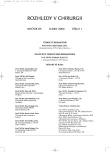-
Medical journals
- Career
Variation of Microvascular Blood Flow Augmentation – Supercharge in Esophageal and Pharyngeal Reconstruction
Authors: M. Sekido 1; Y. Yamamoto 1; H. Minakawa 1; S. Sasaki 1; H. Furukawa 1; T. Sugihara 1; K. Nohira 2; K. Yajima 2; Y. Shintomi 2; S. Okushiba 3; H. Kato 3; A. Watanabe 4; M. Hosokawa 4
Authors‘ workplace: Department of Plastic and Reconstructive Surgery, Hokkaido University Graduate School of Medicine, Sapporo, Japan, Chief Professor: Yuhei Yamamoto, MD, PhD 1; Soshundo Plastic Surgery, Sapporo, Japan, Director: Yoshihisa Shintomi 2; Department of Surgical Oncology, Hokkaido University Graduate School of Medicine, Sapporo, Japan, Chief Professor: Hiroyuki Kato, MD, PhD 3; Keiyukai Sapporo Hospital, Sapporo, Japan, Director: Masao Hosokawa, MD, PhD 4
Published in: Rozhl. Chir., 2006, roč. 85, č. 1, s. 9-13.
Category: Monothematic special - Original
Overview
Aim of the study:
A gastric tube is commonly used in thoracic esophageal reconstruction. When a gastric tube is not available, pedicled jejunum transfer and colonic interposition are alternative methods. Oral end of the reconstructed esophagus occasionally has poor blood flow and may result in partial necrosis of the oral segment We performed additional microvascular blood flow augmentation, the “supercharge” technique, to improve a blood flow circulation in the oral segment of the reconstructed esophagus.Methods:
A series of 86 esophageal reconstructions with microvascular blood flow augmentation using the “supercharge” technique were performed. Reconstructive methods included a gastric tube in five patients, a gastric tube combined with a free jejunual graft in one, an elongated gastric tube in eight, a pedicled colonic interposition in 22, and a pedicled jejunum in 50. Recipient vessels were used in neck or chest region.Results:
The color and blood flow of the transferred intestine appeared greatly improved after microvascular blood flow augmentation. Thrombosis was noticed in three patients during the surgery, and all thrombosies were salvaged by re-anastomosis. There were only three patients with partial graft necrosis of oral segment, two patients with anastomotic leakage, one anastomotic stricture.Conclusions:
Augmentation of microvascular blood flow by this “supercharge” technique can be expected to reduce the risk of leakage and partial necrosis of the transferred intestine. This technique contributes to the successful reconstruction of esophageal defect.Key words:
esophageal reconstruction – supercharge – microsurgery – blood flow augmentation
Labels
Surgery Orthopaedics Trauma surgery
Article was published inPerspectives in Surgery

2006 Issue 1-
All articles in this issue
- Surgical Treatment of Thyreopathies. Retrospective Assessment of the Authors‘ Study Group
- Endoscopic Solution of Iatrogenic Lesion of Oesophagus
- Variation of Microvascular Blood Flow Augmentation – Supercharge in Esophageal and Pharyngeal Reconstruction
- Contemporary Approach to Treatment of the Posttraumatic Empyema of the Thorax
- Tension Pneumofluidothorax of the Right Pleural Cavity Resulting from a Rupture of the Oesophagus during Gastrectasy
- The Glomus Caroticum Tumor – an Unusal Case
- Postoperative Complications of a Perforated Aneurysm of the Abdominal Aorta – a Case Review
- Biliary Reflux in a Reflux Disorder of the Oesophagus
- Laparoscopic Colorectal Surgery for Carcinomas – Assessment of the Authors‘ Patient Group
- Laparoscopic Resection of the Rectum: a Fashionable Extreme or a Golden Standard?
- Safe Distance of the Inferior Resection Line in the Rectal Carcinoma Surgery
- Gas in the Portal and Mesentrial Venous Bed in a Vascular Ileus
- Perspectives in Surgery
- Journal archive
- Current issue
- Online only
- About the journal
Most read in this issue- Biliary Reflux in a Reflux Disorder of the Oesophagus
- The Glomus Caroticum Tumor – an Unusal Case
- Gas in the Portal and Mesentrial Venous Bed in a Vascular Ileus
- Safe Distance of the Inferior Resection Line in the Rectal Carcinoma Surgery
Login#ADS_BOTTOM_SCRIPTS#Forgotten passwordEnter the email address that you registered with. We will send you instructions on how to set a new password.
- Career

